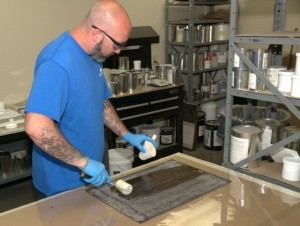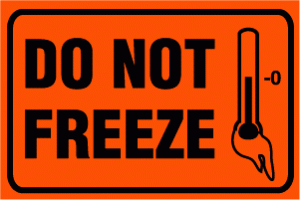As an installer of polymer flooring systems, you unfortunately come across jobsite conditions that you may not have planned for. These range from shortened time constraints, other trades impeding on your area, logistics in transporting and storage of your materials, and about one hundred other things that can literally drive you to chuck your roller out the window. With Polymer coatings, one of your most influential factors is colder temperatures in the winter months.
Polymers floor coatings, such as polyurethane and epoxies, are greatly affected by substrate and air temperature at the application site. As well, and often not thought about, is the transport temperature of your materials. The facility receiving the new floor coating may have the perfect interior conditions regarding air and substrate temperature, but if the material has been driven or stored in the back of a cold truck over the weekend and arrives at temperatures well below their optimum performance capabilities, you could be in for a long day.
Polymer Flooring materials undergo quality control testing at the manufacturing facility before they are released for sale. To maintain good quality control practice, the temperature setting within the testing lab is kept constant, most often at 70-75 degrees Fahrenheit. These are ideal conditions for these types of materials. This assures that every batch is checked in a similar environment, as well as an environment where you ideally want to install them.
As a general rule, for every ten degrees drop in temperature, the thin film set time for epoxies and urethanes will essentially double. Simply put, if you have allotted a six hour time frame for your epoxy floor to cure and be ready to receive a top coat of urethane (assuming that the area was going to be 70 degrees), yet find a 60 degree reality, you probably have added another day to the install and cost yourself, and the customer, cherished time and money. In this case, ten degrees can make a huge impact on your intended timeline.
Temperature also plays a factor in the way polymer floor coating materials handle and feel to your application technicians. Low temperatures can hinder a coating’s ability to level out, resulting in increased roller marks, or sticky coatings which can pull more lint from your roller and transfer it to the floor surface. Lower temperatures can also impact mortars and slurries, making them much harder to spread uniformly. Additionally, and especially with epoxies, colder temperatures naturally drop the dew point. Along with a longer curing open time, condensing moisture in the air can make your coating much more susceptible to the dreaded amine blush phenomenon. Faced with this, now you have additional labor steps of washing or sanding the “blushed” floor coating, and likely both.
It is vitally important to plan and have an understanding of all of the conditions of your installation ahead of time.
- Know what the normal operating temperatures are of the area and ask if you can raise or lower them to the ideal operating range of your materials.
- Plan ahead and make sure that the area where your customer is allowing you to store and mix your materials is acceptable. If neither is ideal, include in the contract the consequences and contingent plans and costs associated with adverse jobsite conditions.
- Be sure to have 24 hour contact information so no one is surprised the next day should a coating not cure in the time frame expected.
- Anticipate shipping conditions of your materials and whether or not there will be time once they arrive to get them acclimated to the environment.
It is important to consider the consequences and costs of shipping polymer flooring materials, especially in the colder months when materials have the potential to be stored in a truck over the weekend. It might be worth the extra cost of waiting to ship materials, or even express shipping the next business week. You may even want to consider temperature controlled shipping services.
Cold or frozen shipments of polymer floor coating materials can be detrimental to the success of your flooring project
In the very fast world of polymer flooring Installation, with its sudden last minute opportunities, scrambling for available labor and time, quick bids, material availability and lead times, please remember that colder temperatures can be something that is easily forgotten, but a nightmare to deal with if not planned for properly.
Do you have a flooring project, but don’t know where to start? Our Industrial Flooring Self-Assessment Tool can help you determine the ideal solution for your unique application.
- Aesthetics: The Art and Science of Decorative Flooring - August 28, 2025
- Why Epoxy Mortar Outperforms Traditional Concrete in Industrial Applications - August 27, 2025
- How Antimicrobial Flooring Supports Health and Safety in Critical Environments - August 22, 2025




